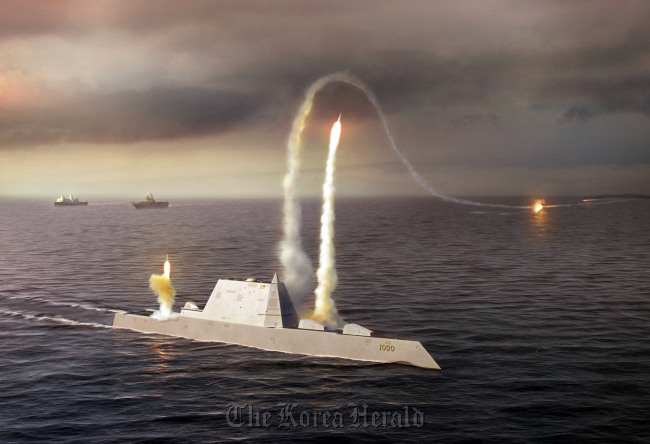Budget constraints get in way of pursuing high-tech weapons projects
By Korea HeraldPublished : July 5, 2012 - 20:17
The U.S. is focusing on securing strategic military assets with radar-evading capability to help offset China’s anti-access/area-denial capabilities.
To help neutralize China’s increasingly sophisticated missile capabilities, the U.S. is seeking to introduce stealth warships and more fifth-generation combat aircraft such as the DDG-1000 Zumwalt-class destroyer and F-35 combat aircraft.
Along with its missile defense program and other advanced military assets, these high-tech weapons are to be integrated into the new AirSea Battle concept that will underpin the U.S.’ war-fighting doctrine.
The new concept involves integrated aerial and naval operations across all domains such as air, maritime, space and cyberspace to neutralize the A2/AD capabilities.
“Stealth assets will help respond to anti-access challenges although we cannot say the U.S. could entirely offset them only with them. Overall, the U.S. has more advanced, upgraded weapons systems including missile defense capabilities,” said Yang Uk, a senior research fellow at Korea Defense and Security Forum.
“China has recently flexed its military muscles with missiles, an aircraft carrier and its indigenous J-20 stealth fighter jet. But the level of maturity, accuracy and their actual battle performances have yet to be proven compared with America’s combat-proven assets.”
To help neutralize China’s increasingly sophisticated missile capabilities, the U.S. is seeking to introduce stealth warships and more fifth-generation combat aircraft such as the DDG-1000 Zumwalt-class destroyer and F-35 combat aircraft.
Along with its missile defense program and other advanced military assets, these high-tech weapons are to be integrated into the new AirSea Battle concept that will underpin the U.S.’ war-fighting doctrine.
The new concept involves integrated aerial and naval operations across all domains such as air, maritime, space and cyberspace to neutralize the A2/AD capabilities.
“Stealth assets will help respond to anti-access challenges although we cannot say the U.S. could entirely offset them only with them. Overall, the U.S. has more advanced, upgraded weapons systems including missile defense capabilities,” said Yang Uk, a senior research fellow at Korea Defense and Security Forum.
“China has recently flexed its military muscles with missiles, an aircraft carrier and its indigenous J-20 stealth fighter jet. But the level of maturity, accuracy and their actual battle performances have yet to be proven compared with America’s combat-proven assets.”

China’s enhanced missile capabilities have posed a grave challenge to the naval operations of the U.S. and its allies, particularly in the South China Sea where significant maritime interests are at stake. The region, beset by maritime disputes, is a confluence of major shipping routes linking energy storehouses of the Middle East.
Budget constraints have hindered Washington’s pursuit of such state-of-the-art weapons systems. The U.S. government is reorganizing its defense priorities as it seeks to slash $487 billion in its defense spending over the next decade.
The DDG-1000 Zumwalt is the U.S. Navy’s next-generation destroyer. The radar-evading warship is expected to be the centerpiece of the American Navy’s strategy to counterbalance China’s maritime anti-access capabilities.
Built from the kneel up to be stealthy, the Zumwalt-class destroyer is to be designed for land attack, littoral dominance and with capabilities against anti-ship cruise missiles. The Zumwalt is expected to be delivered in the fiscal year 2014.
The U.S. initially planned to introduce dozens of DDG-1000-class warships whose per-unit price is estimated at $3.3 billion. But it now plans to purchase only three due to budget limits.
To counter ASBM threats from China, the U.S. is also trying to upgrade its DDG-51 USS Arleigh Burke-class guided missile destroyers.
For enhanced aerial strike capabilities, the U.S. is to introduce the F-35 fifth-generation stealth fighter jet.
The F-35 has been co-developed with eight foreign partners ― Britain, Italy, the Netherlands, Turkey, Canada, Australia, Denmark and Norway ― since 2001. The single-seat, single-engine F-35 jet with a maximum speed of mach 1.8 has three different variants.
The U.S. military’s plan was to secure 2,400 F-35s over the next two decades with a budget of $400 billion. But due to Washington’s belt-tightening efforts, it is moving to scale down its fighter jet procurement project.
Washington has reportedly decided to postpone its acquisition of more than 170 F-35 fighters out of the 423 units it initially planned to purchase by 2017.
To expand its maritime defense, China has focused on developing sea-launched ballistic missiles and anti-ship ballistic missiles with diversified striking ranges and enhanced precision-strike capabilities. ASBMs are dubbed “aircraft carrier killers.”
“With China’s changing strategic priorities coupled with transformation of its defense industries over the last decade, we see a growing sophistication in China’s strategic and conventional missile capabilities,” said Michael Raska, associate research fellow at the S. Rajaratnam School of International Studies, Nanyang Technological University.
By Song Sang-ho (sshluck@heraldcorp.com)
-
Articles by Korea Herald




![[Herald Interview] 'Amid aging population, Korea to invite more young professionals from overseas'](http://res.heraldm.com/phpwas/restmb_idxmake.php?idx=644&simg=/content/image/2024/04/24/20240424050844_0.jpg&u=20240424200058)












![[KH Explains] Korean shipbuilding stocks rally: Real growth or bubble?](http://res.heraldm.com/phpwas/restmb_idxmake.php?idx=652&simg=/content/image/2024/04/25/20240425050656_0.jpg&u=)

